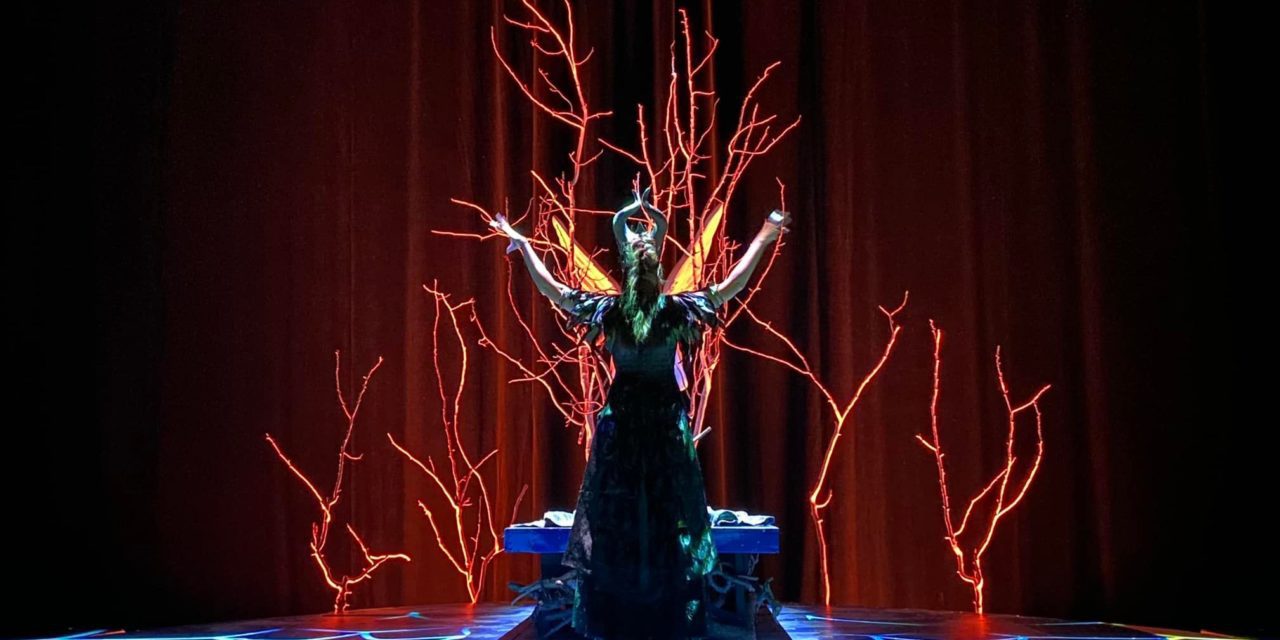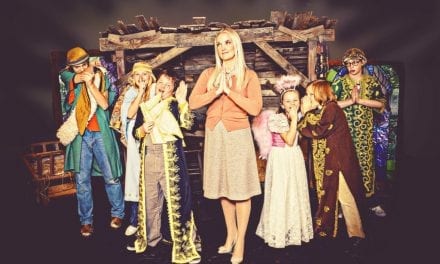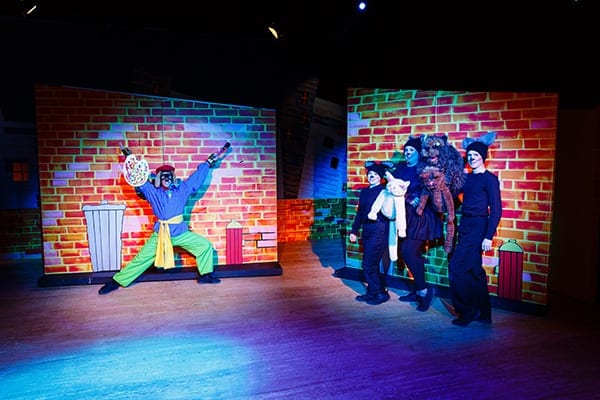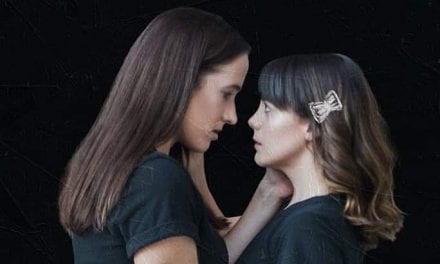SALT LAKE CITY — When I walked into the black box space of the Regent Street theatre to attend Sting and Honey’s production of Sleeping Beauty’s Dream, I immediately knew I was in for a sensory delight. Already the stage picture was intriguing and beautiful: a raised circular platform provided a creative performance space, with symbolic images incorporated into the design. Brambles surrounded the platform and climbed up a large statue of an angel, positioned at the head of what would become Aurora’s plinth, which held a golden helmet. Javen Tanner’s set design served his story well and was used to good effect in his storytelling.
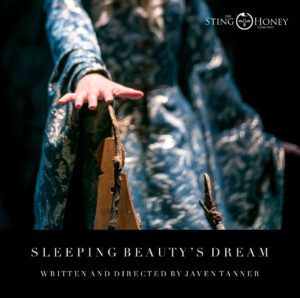
Show closes July 30, 2022.
Sleeping Beauty’s Dream is Javen Tanner’s brainchild from concept to realization. His take on the Sleeping Beauty myth begins with the familiar Brothers Grimm fairy tale yet goes well beyond it to explore the sleeping princess trope from Norse legends, and even dipping into some Greek and Irish mythologies to add to the mix. The result is an intriguing, thought-provoking take on a familiar tale that spends considerable time exploring mother/daughter relationships and less on looking for a true love.
The play also asks the question: what did Aurora dream about during those 100 years while she and the entire population of her kingdom was asleep? Javen Tanner’s answer is fascinating: what if Aurora dreams that she is Brunhilde, a Valkyrie who is cursed by Odin to sleep in a ring of fire because she did not love him. In turn, while Brunhilda sleeps, she dreams she is a princess who pricks her finger and falls asleep.
The story spends the bulk of the time in Brunhilde’s world of battle and gods and Valkyries, while three good witches (and one bad, of course) bounce back and forth between the two, guarding and guiding, but not able to force choices. Rather than the three little biddies who sort of bumble about in one of the more familiar renditions of this fairytale, these witches are taken from Greek mythology and are named Nyx, called Mother Night (played by Kathryn Atwood); Ananke, Keeper of Time (played by Susan Maurer Barry); and Hebe, Fountain of Youth (played by Liberty Miller). The villain is a witch called Sycorax, breaker of hearts, played by Deena Marie Manzanares with appropriate venom and spite. In an added layer of intrigue, Nyx is the mother of Sycorax, and the Valkyries of Norse legend (including Brunhilde); Ananke is the mother of the Fates; and Sycorax is also the mother of Caliban in Shakespeare’s The Tempest. This makes Sleeping Beauty’s Dream a fascinating interweaving of storylines from different cultures and times to tell a complex tale of mothers and daughters.
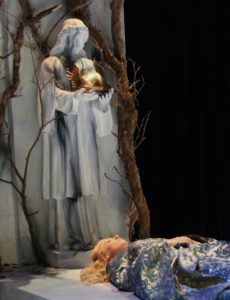 Because Javen Tanner was playwright, director, composer, and scenic designer, it could be supposed that the end product was everything that he wanted it to be (within the limitations of budget and physics, of course). Javen Tanner was very fortunate in his lighting designer, Emma Bayless, who caught the vision and created stunning lighting effects and emotions to compliment the action. Bayless used her lighting skills to enhance the story, focus attention, and share emotion. Thanks to Javen Tanner and Bayless, the set design and lighting design worked in perfect unison in this production. The costume design by Tara Lynn Tanner was effective in helping the audience to keep track of characters. And while the witches’ gowns looked like they were just pulled from stock and parceled out, they were very successful with color-coding for the witches and golden wings and armor for the chorus of Valkyries. Aurora/Brunhilde’s costumes were beautiful and age appropriate; any young girl would love to wear Aurora’s flowing robes and Brunhilde’s badass golden armor.
Because Javen Tanner was playwright, director, composer, and scenic designer, it could be supposed that the end product was everything that he wanted it to be (within the limitations of budget and physics, of course). Javen Tanner was very fortunate in his lighting designer, Emma Bayless, who caught the vision and created stunning lighting effects and emotions to compliment the action. Bayless used her lighting skills to enhance the story, focus attention, and share emotion. Thanks to Javen Tanner and Bayless, the set design and lighting design worked in perfect unison in this production. The costume design by Tara Lynn Tanner was effective in helping the audience to keep track of characters. And while the witches’ gowns looked like they were just pulled from stock and parceled out, they were very successful with color-coding for the witches and golden wings and armor for the chorus of Valkyries. Aurora/Brunhilde’s costumes were beautiful and age appropriate; any young girl would love to wear Aurora’s flowing robes and Brunhilde’s badass golden armor.
Rain Flower Tanner fit the picture of a beautiful princess perfectly, and while she is very young, showed great promise as an actor. Her two devoted beaux, Bijan Hosseini and Alec Kalled each portrayed two more devoted beaux: Tithonos and Kephalos (suitors to Aurora) and Odin and Siegfried (suitors to Brunhilde), respectively to great effect. It must have been a rewarding opportunity to delve into these men, representing two halves of their characters and intentions.
In the midst of all the earnest wooing and fighting and rebelling entered the comic relief of the plot, a clown called simply Robin who was brought to life by Will Kempe in a hysterical triumphant comedic turn. Kempe was perfectly cast as the foil to Sycorax’s evil meanness and brought humor as well as some pathos to the story. But mostly Robin was just fun. Not to give anything away, but his scenic interlude with a handful of poison dart frogs had me laughing so hard I could not breathe.
Overall, Sleeping Beauty’s Dream is a captivating take on a classic story. The rhyming couplets, minimal sets, and jester trope feels a lot like Shakespeare and might take a minute for the audience’s brain to wrap around, but it is worth it because the production values are impressive. Javen Tanner creates beautiful stage pictures with his actors, although the blocking itself feels somewhat stagnant. There are several fight sequences (it is a story about Valkyries after all) that utilize both regular paced and stylized slow-motion choreography. Both work well, but the stylized fights are more effective. Tanner also uses the Shakespearean soliloquy often, having each witch address the audience directly from time to time.
The director’s note indicates that this play is one of a trilogy including Snow White and Cinderella, which they plan to produce in the following years. It would be a fun tradition to attend these fairytales each year. Javen Tanner always brings interesting insights into the stories that he chooses to tell. The Sting and Honey Company are a boon to the theatre community here in Utah, and I have never been disappointed by any of their productions. I strongly recommend catching this Dream before it leaves.

These reviews are made possible by a grant from the Salt Lake County Zoo, Arts, and Parks program.

